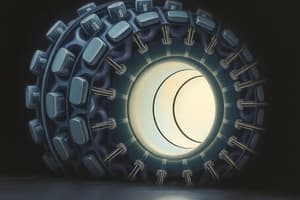Podcast
Questions and Answers
What is a major advantage of using small coils in MRI?
What is a major advantage of using small coils in MRI?
- Increased signal coverage
- Reduced likelihood of aliasing with large FOV
- Less critical positioning of the patient
- Higher SNR and potential for higher resolution (correct)
What is the primary benefit of using phase array coils in MRI?
What is the primary benefit of using phase array coils in MRI?
- Improved signal coverage in large examinations
- Reduced aliasing artefact in all examinations
- Combination of benefits from small and large coils (correct)
- Increased SNR in small body part examinations
What is the consequence of using large coils in MRI with small fields of view?
What is the consequence of using large coils in MRI with small fields of view?
- Decreased likelihood of phase artefact
- Increased likelihood of aliasing artefact (correct)
- Reduced noise from the entire imaging volume
- Improved SNR and higher resolution
What is the primary function of the array processor in the MRI system?
What is the primary function of the array processor in the MRI system?
In which type of examination would a large coil be more suitable?
In which type of examination would a large coil be more suitable?
What is the primary function of gradient coils in MRI systems?
What is the primary function of gradient coils in MRI systems?
What is the purpose of the operator control panel in the MRI system?
What is the purpose of the operator control panel in the MRI system?
Why is it important to ensure that RF coil cables are not looped or touching the patient or the bore of the magnet?
Why is it important to ensure that RF coil cables are not looped or touching the patient or the bore of the magnet?
What is the purpose of shim coils in MRI systems?
What is the purpose of shim coils in MRI systems?
Why are RF coils critical for image optimization in MRI systems?
Why are RF coils critical for image optimization in MRI systems?
What is the purpose of correctly tuning the RF coils in MRI systems?
What is the purpose of correctly tuning the RF coils in MRI systems?
How are RF coils typically tuned in modern MRI systems?
How are RF coils typically tuned in modern MRI systems?
What is the purpose of SCIC in MRI?
What is the purpose of SCIC in MRI?
What is the result of non-uniform signal in MRI?
What is the result of non-uniform signal in MRI?
What is the advantage of phased array coils?
What is the advantage of phased array coils?
How do parallel imaging coils work?
How do parallel imaging coils work?
What is the advantage of using multiple coils in parallel imaging?
What is the advantage of using multiple coils in parallel imaging?
What is the maximum number of coils and receivers that can be grouped together in parallel imaging?
What is the maximum number of coils and receivers that can be grouped together in parallel imaging?
Flashcards are hidden until you start studying
Study Notes
MRI Coils
- Gradient coils produce controlled variations in the main magnetic field (B0) for spatial localization of signals and position-dependent variation of signal frequency.
- Radiofrequency coils receive and/or transmit the RF signal.
- Shim coils provide supplementary magnetic fields to compensate for inhomogeneities in the main magnetic field.
Coil Safety
- Cables must consist of a conductive material to deliver RF power and send signals to the image processor.
- Coils should have the capacity to transmit heat during normal operation.
- Coil safety considerations include:
- Avoiding looped or touching cables with the patient or magnet bore.
- Keeping cables away from other wires or cables, such as ECG leads.
- Regularly inspecting coil cables and not using them if protection is damaged.
Radiofrequency Coils
- RF coils are critical for image optimization and the selection of the right coil for the area under examination is essential.
- Large coils provide large coverage but relatively poor SNR due to noise from the entire imaging volume.
- Small coils provide small coverage but relatively good SNR due to reduced noise.
- Phase array coils combine the benefits of small and large coils, providing optimal SNR and coverage.
Pulse Control Unit
- The pulse control unit synchronizes the application of gradients and RF pulses in a pulse sequence.
Coil Types
- Large coils:
- Provide a large area of uniform signal reception.
- Increase the likelihood of aliasing with small FOV.
- Are less critical for patient positioning.
- Have lower SNR, allowing only for lower resolution.
- Are used in examinations of the torso, such as the chest and abdomen.
- Small coils:
- Provide a small area of signal reception.
- Are less likely to produce aliasing artefacts.
- Require critical patient and coil positioning.
- Have high SNR, allowing for higher resolution.
- Are used in examinations of small body parts, such as the wrist, spine, and knee.
Phased Array Coils
- Combine the advantages of small surface coils (increased SNR and resolution) with a large FOV for increased anatomy coverage.
- Consist of multiple coils and receivers (up to four) grouped together to increase longitudinal coverage or improve uniformity across a whole volume.
- Individual signals are combined to create one image with improved SNR and increased coverage.
Operator Interface
- Consists of:
- Operator control panel for controlling all system functions and image viewing.
- A computer with specified capabilities.
- Array processor for Fourier transformation.
- Image processor that takes data from the array processor to form the image.
- Hard disc drives for storage of raw data and pulse sequence parameters.
- Power distribution mechanism to distribute and filter the alternating current.
Studying That Suits You
Use AI to generate personalized quizzes and flashcards to suit your learning preferences.




